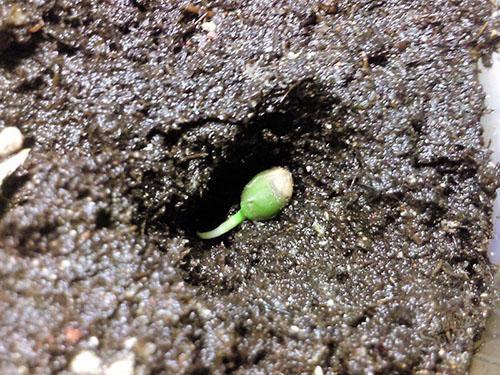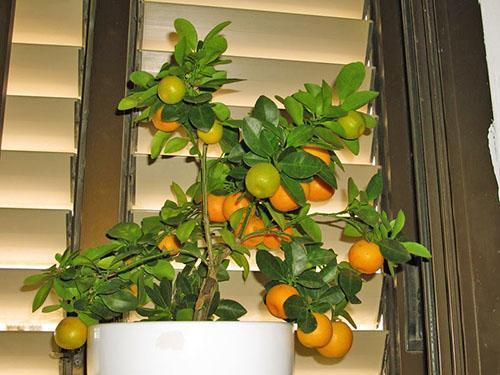Indoor tangerine is a vivid embodiment of a good mood in the house!
 Most florists agree that among the abundance of "domestic" plants, indoor mandarin takes a separate place. The ornamental shrub not only pleases the eye with its bright, cheerful color of leaves and fruits, but also has a beneficial effect on the atmosphere in the home. It has been proven that a subtle, light aroma helps to get rid of headaches, relieves irritation, anxiety, gives a feeling of vigor, and improves mood. In addition, growing tangerines at home does not require a lot of effort, and this is also one of the important advantages.
Most florists agree that among the abundance of "domestic" plants, indoor mandarin takes a separate place. The ornamental shrub not only pleases the eye with its bright, cheerful color of leaves and fruits, but also has a beneficial effect on the atmosphere in the home. It has been proven that a subtle, light aroma helps to get rid of headaches, relieves irritation, anxiety, gives a feeling of vigor, and improves mood. In addition, growing tangerines at home does not require a lot of effort, and this is also one of the important advantages.
How to turn a tiny seed into a flowering tree?

For the plant to take root well, you need to take the seeds of ripe, juicy, large fruits. It is desirable that there are more seeds (10 -12 pieces, so the chance of the "event" for success will be much higher!
Before planting seeds in the ground (purchased or "obtained" from a personal plot), you need to place them in a humid environment for several days (it is better to wrap them in clean gauze and slightly moisten it with water). During this time, the bones will swell, and tiny sprouts will hatch on them. When this happens, it's time to start directly planting the plant in the ground.
 Despite the fact that indoor tangerine is unpretentious to the type of soil, experts still recommend that you approach this moment responsibly. So, the best solution would be to independently prepare a special mixture (if possible), which will include the following components:
Despite the fact that indoor tangerine is unpretentious to the type of soil, experts still recommend that you approach this moment responsibly. So, the best solution would be to independently prepare a special mixture (if possible), which will include the following components:
- sheet land - 1 part;
- turf soil - 3 parts;
- rotted cow dung - 1 part;
- clay;
- sand.
 Drainage is placed on the bottom of a clean, dry container (as a rule, small ordinary pebbles or expanded clay act as drainage), after which the pot is filled with a thoroughly mixed composition of the above components. The swollen seeds are placed in the ground to a depth of 5-7 cm. It is recommended to place the container with the planted seeds in a well lit place.
Drainage is placed on the bottom of a clean, dry container (as a rule, small ordinary pebbles or expanded clay act as drainage), after which the pot is filled with a thoroughly mixed composition of the above components. The swollen seeds are placed in the ground to a depth of 5-7 cm. It is recommended to place the container with the planted seeds in a well lit place.
Direct sunlight should be avoided, since only fragile shoots that have appeared can simply burn out!
Homemade tangerine - care and feeding
 About three weeks after planting in the ground, the first shoots should appear from the tangerine tree seed. From this moment, you can start feeding the plant, since the mineral and organic substances originally contained in the soil are quickly washed out as a result of regular watering. In specialized flower shops, you can easily pick up mixtures for fertilizing and feeding citrus fruits.
About three weeks after planting in the ground, the first shoots should appear from the tangerine tree seed. From this moment, you can start feeding the plant, since the mineral and organic substances originally contained in the soil are quickly washed out as a result of regular watering. In specialized flower shops, you can easily pick up mixtures for fertilizing and feeding citrus fruits.

Particular attention should be paid to fertilization in the spring, when indoor mandarin develops most intensively. Like most indoor plants, the tree needs to be fertilized in the morning, while the temperature mineral mixture should vary between 18-20 ° C. The composition of the fertilizer can be different, but components such as phosphorus, potassium and nitrogen must be present.
In no case should the formula for the preparation of the nutritional mixture or solution be violated.The manufacturer always indicates on the packaging in what proportions to use this or that product. An irrational approach to tangerine feeding can lead to burns to the stem, leaves, or even the complete death of the plant.
The period of intensive growth of indoor mandarin is considered to be from March to September. The optimal feeding frequency is 2 times a week. The plant will surely "thank" with lush, fragrant flowers and beautiful fruits, if the owner combines mineral and organic fertilizers (for example, rotted cow dung).
The main rules for caring for a tangerine tree
 All plants love care and attention, and tangerines are no exception. How to care for indoor tangerine so that the tree is healthy, strong and beautiful? Professional florists distinguish several main points in the care rules:
All plants love care and attention, and tangerines are no exception. How to care for indoor tangerine so that the tree is healthy, strong and beautiful? Professional florists distinguish several main points in the care rules:
- Partial flower removal on a young plant. This is done in order not to drain the tree during the intensive growth process. Let only a few flowers remain on the stem, but later beautiful, large fruits will turn out from them.
- Timely removal of elongated twigs and dried leaves.
- Pinching the tops of the branches. This is necessary for the tree to form a lush, dense crown.
 When fruits are tied on the branches of a tree, it is recommended to tie the stem and branches of the plant to a support.
When fruits are tied on the branches of a tree, it is recommended to tie the stem and branches of the plant to a support.
What could be a threat to the tangerine tree?
 Good care is sometimes not enough for the long "life" of citrus fruits, in no case can such a threat as pests be ignored. Small, almost invisible red spider mites, citrus whiteflies or scale insects can cause great harm to the plant. In order to prevent the death of the tangerine tree, at the slightest suspicion of pests, wipe all the leaves with special solutions (Fitoverm, Aktellik, etc.). A few procedures are enough, and all unwanted guests will disappear.
Good care is sometimes not enough for the long "life" of citrus fruits, in no case can such a threat as pests be ignored. Small, almost invisible red spider mites, citrus whiteflies or scale insects can cause great harm to the plant. In order to prevent the death of the tangerine tree, at the slightest suspicion of pests, wipe all the leaves with special solutions (Fitoverm, Aktellik, etc.). A few procedures are enough, and all unwanted guests will disappear.
Which varieties are suitable for growing at home?
 Some of the most popular tangerine tree varieties ideal for home growing include:
Some of the most popular tangerine tree varieties ideal for home growing include:
- Shiva Mikan
- Unshiu
- Clementine
- Marcotte
Each of these varieties has its own specifics, but in any case, the owner of the plant will be provided with spectacular flowers with a pronounced aroma and sweet, ripe fruits.
A tangerine at home is fortunately)) Just try not to stumble upon fakes. Itself several times bought some unsuccessful trees.